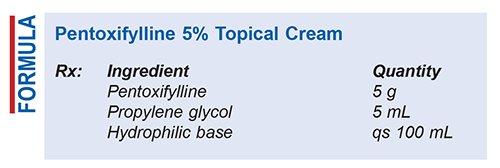US Pharm. 2024;49(11):59-60.

Method of Preparation: Calculate the required quantity of each ingredient for the total amount to be compounded, and weigh and/or measure each ingredient. In a mortar, mix the pentoxifylline with the propylene glycol (PG) until a smooth paste forms. Gradually, geometrically incorporate a hydrophilic base (or other base of choice) by adding small amounts of the base to the pentoxifylline mixture and mixing thoroughly until a homogenous cream is obtained. When the cream is ready, package and label.
Use: Pentoxifylline topical cream has been used for diabetic wound care, and it is commonly applied in the management of peripheral vascular diseases such as intermittent claudication.
Packaging: Package in a tight, light-resistant container. Store at controlled room temperature.
Labeling: Keep out of reach of children. Use only as directed. External use only. Store in a cool, dry place. Discard after [time period].1
Stability: The default beyond-use date for water-containing topical, dermal, and mucosal liquids and semisolids is 30 days at room temperature.2 However, stability studies have demonstrated that pentoxifylline topical formulations can remain stable for at least 62 days when stored at room temperature.3
Quality Control: Weight/volume, pH, specific gravity, active drug assay, color, rheologic properties/pourability, physical observation, and physical stability (discoloration, foreign materials, gas formation, mold growth) are all examples of quality-control assessments).2
Discussion: Pentoxifylline (Trental, C13H18N4O3, MW 278.31) is a synthetic derivative of dimethylxanthine that modulates blood flow by decreasing viscosity, which enhances oxygen delivery to tissues, particularly in patients with chronic peripheral arterial disease. Known for its antioxidant and anti-inflammatory effects, pentoxifylline is commonly prescribed for intermittent claudication associated with chronic occlusive arterial conditions of the limbs. Topical formulations of pentoxifylline enable localized treatment, which has the advantage of reduced systemic side effects compared with oral administration; this is especially beneficial for patients who are unable to tolerate the oral form or those requiring targeted therapy. Adverse reactions of pentoxifylline include gastrointestinal discomfort (e.g., nausea, bloating, diarrhea) and dizziness. Pentoxifylline is contraindicated in patients with recent cerebral or retinal hemorrhage and in patients with hypersensitivity to methylxanthines (e.g., caffeine, theophylline, theobromine).4,5
PG (C3H8O2) is a clear, colorless, odorless, viscous liquid with a sweet, glycerin-like taste. It is miscible with water, acetone, chloroform, ethanol (95%), and glycerin but is not miscible with fixed oils or light mineral oil. In pharmaceutical preparations, PG acts as a humectant, preservative, solvent, or cosolvent in topicals, aerosols, oral solutions, parenterals, and emulsions. It also stabilizes formulations by carrying flavors and emulsifiers. Because PG is hygroscopic, it must be stored in an airtight container and protected from light. In topical applications, PG enhances skin penetration, which improves the absorption of active ingredients. However, prolonged use or high concentrations may cause irritation or allergic reactions in sensitive individuals. Therefore, it is important to carefully consider the formulation and patient tolerability when using PG in topical products.6
Hydrophilic ointments are water-removable, oil-in-water emulsions that typically contain ingredients such as methylparaben, propylparaben, sodium lauryl sulfate, PG, stearyl alcohol, white petrolatum, and purified water. These formulations can incorporate oil-soluble medications. A variety of topical vehicles may be substituted for hydrophilic bases. Although most studies employ oil-in-water cream bases for topical preparations, it is possible to create a lotion by gradually adding preserved purified water during mixing. Dermabase and Vanicream are examples of hydrophilic emulsion bases commonly used in topical preparations. Vanicream is used primarily as a moisturizing cream for sensitive skin.7,8
REFERENCES
1. U.S. Pharmacopeia/National Formulary [current revision]. Rockville, MD: U.S. Pharmacopeial Convention, Inc; September 2022.
2. Allen LV Jr. Standard operating procedure for physical quality assessment of ointments/creams/gels. IJPC. 1998;2:308-309.
3. Gupta VD. Chemical stability of pentoxifylline in a topical cream. Int J Pharm Compd. 2012;16(1):80-81.
4. Trental (pentoxifylline). Bridgewater, NJ: sanofi-aventis U.S. LLC; February 2015.
5. Hassan I, Dorjay K, Anwar P. Pentoxifylline and its applications in dermatology. Indian Dermatol Online J. 2014;5(4):510-516.
6. Weller PJ. Propylene glycol. In: Rowe RC, Sheskey PJ, Quinn ME, eds. Handbook of Pharmaceutical Excipients. 6th ed. Washington, DC: American Pharmaceutical Association; 2009:592-594.
7. Reilly WJ Jr. Pharmaceutical necessities. In: Gennaro AR, ed. Remington: The Science and Practice of Pharmacy. 19th ed. Easton, PA: Mack Publishing Co; 1995:1402.
8. Block LH. Medicated applications. In: Gennaro AR, ed. Remington: The Science and Practice of Pharmacy. 19th ed. Easton, PA: Mack Publishing Co; 1995:1586.
The content contained in this article is for informational purposes only. The content is not intended to be a substitute for professional advice. Reliance on any information provided in this article is solely at your own risk.
To comment on this article, contact rdavidson@uspharmacist.com.





